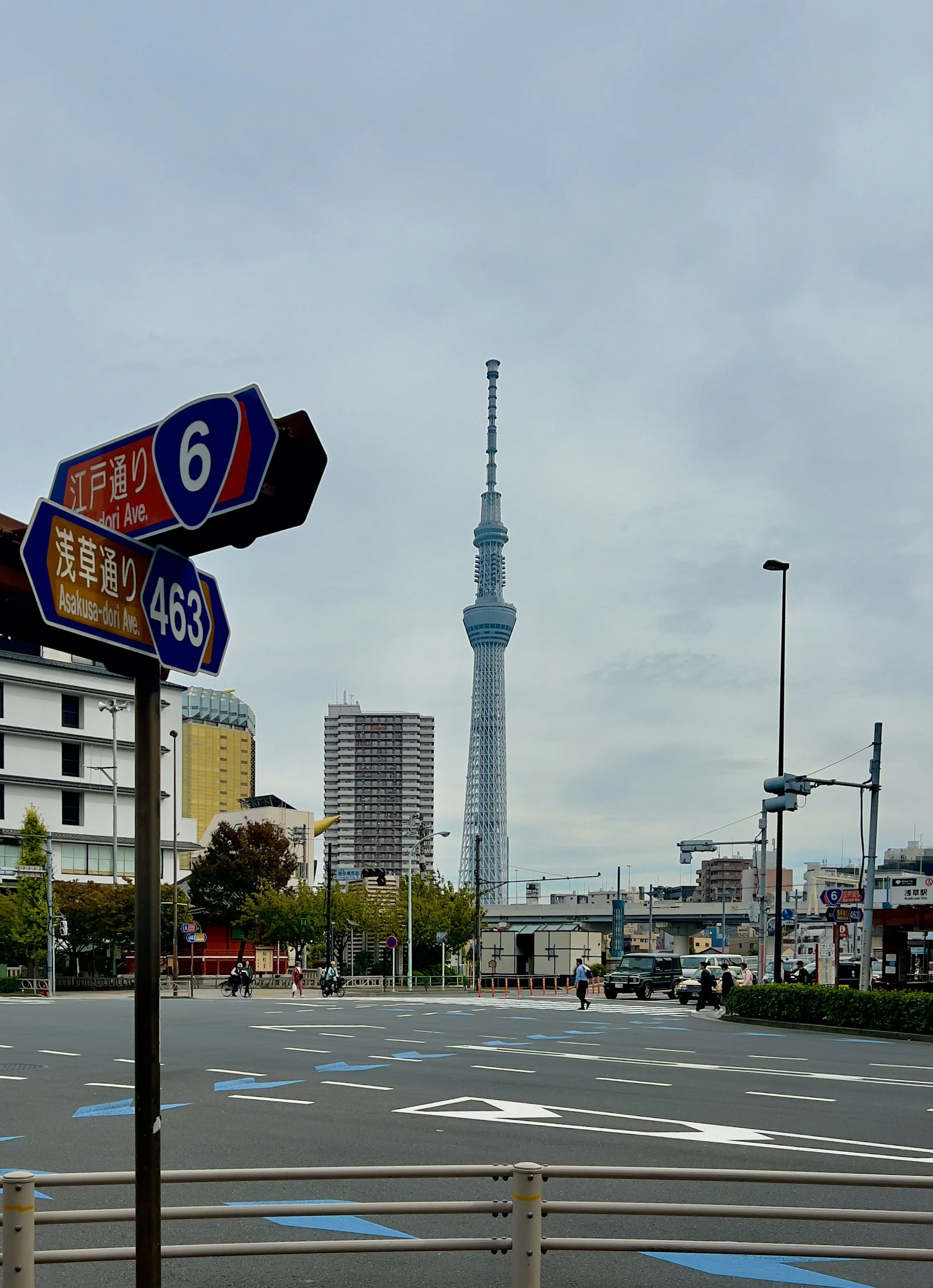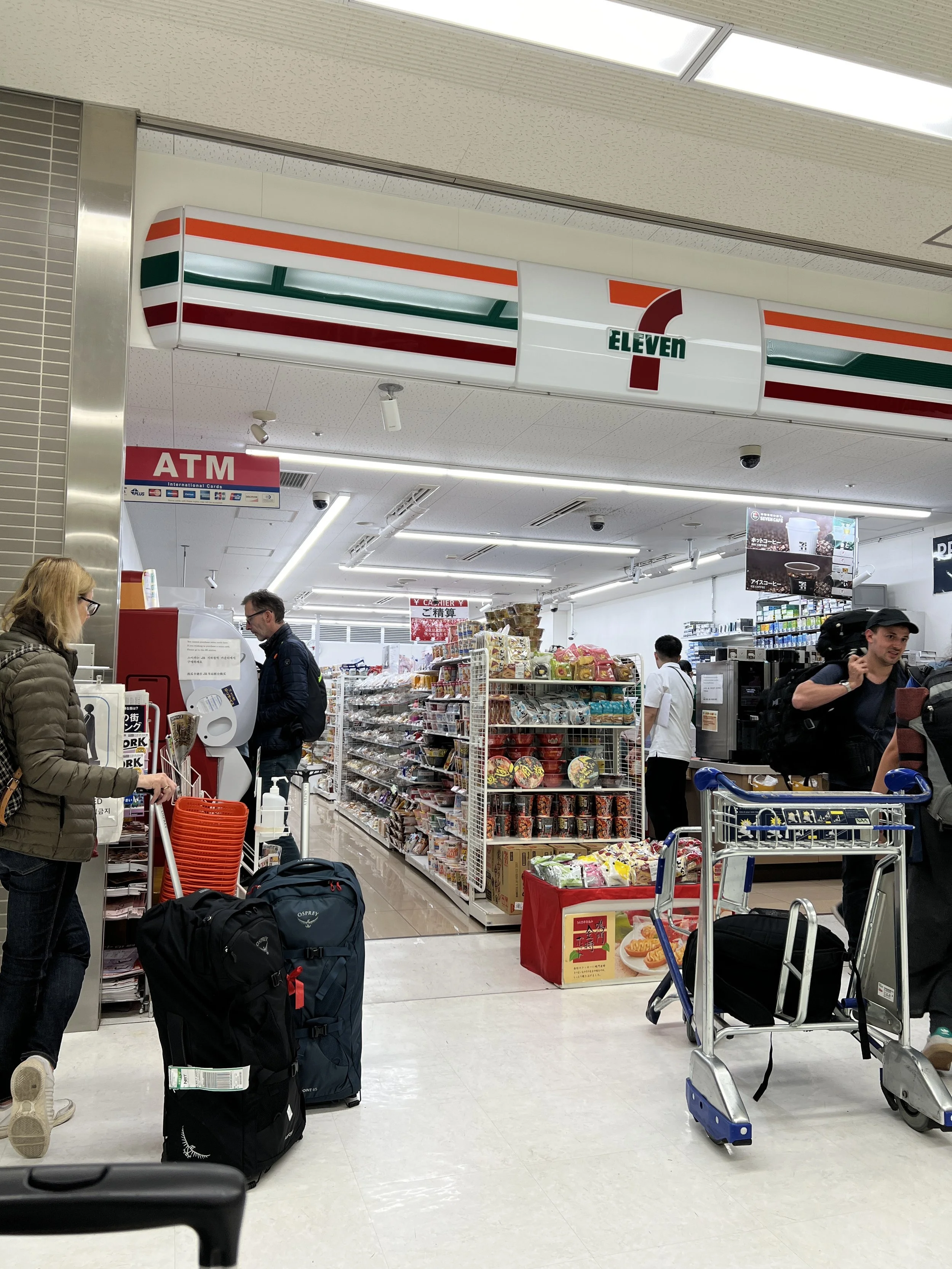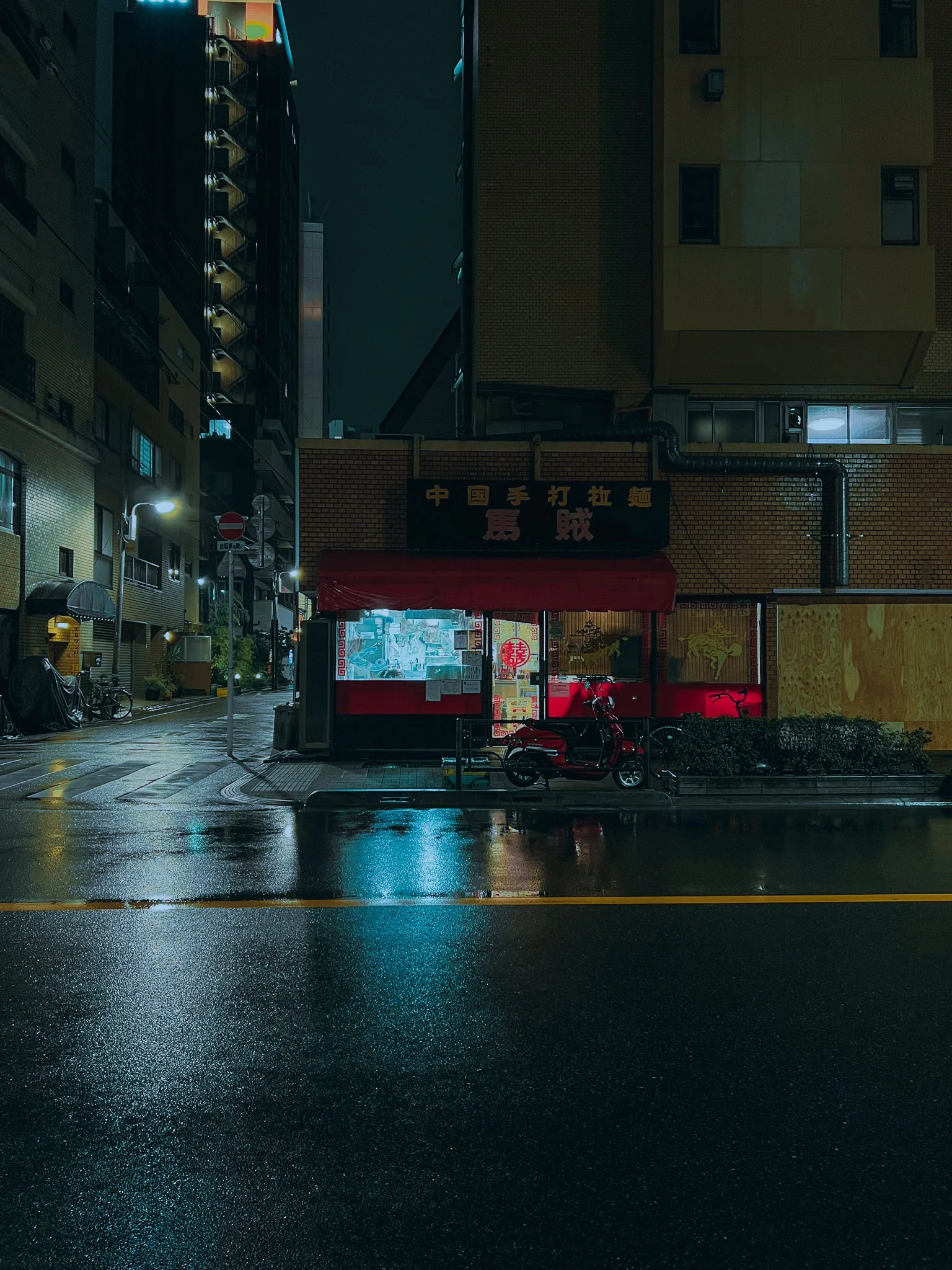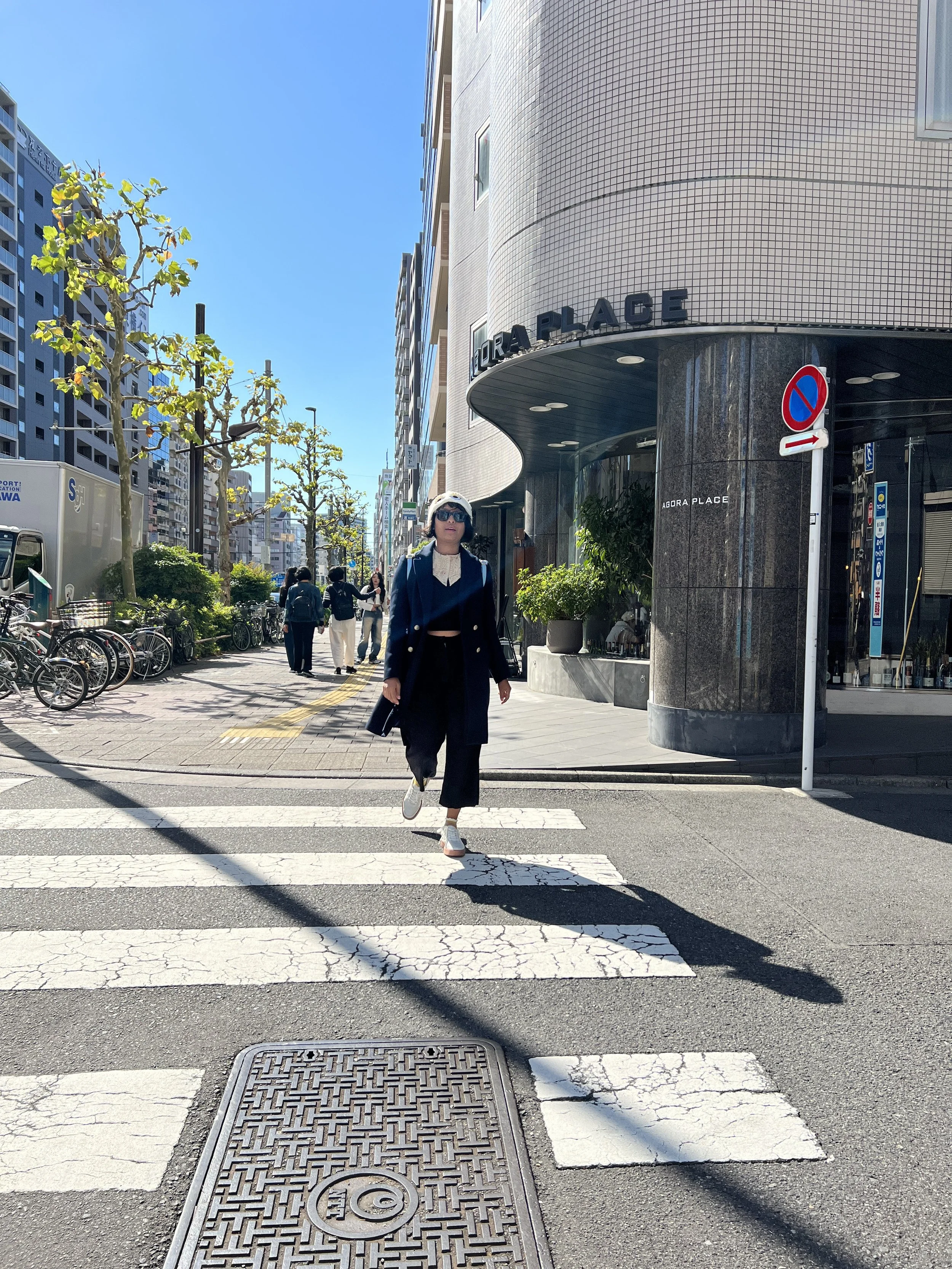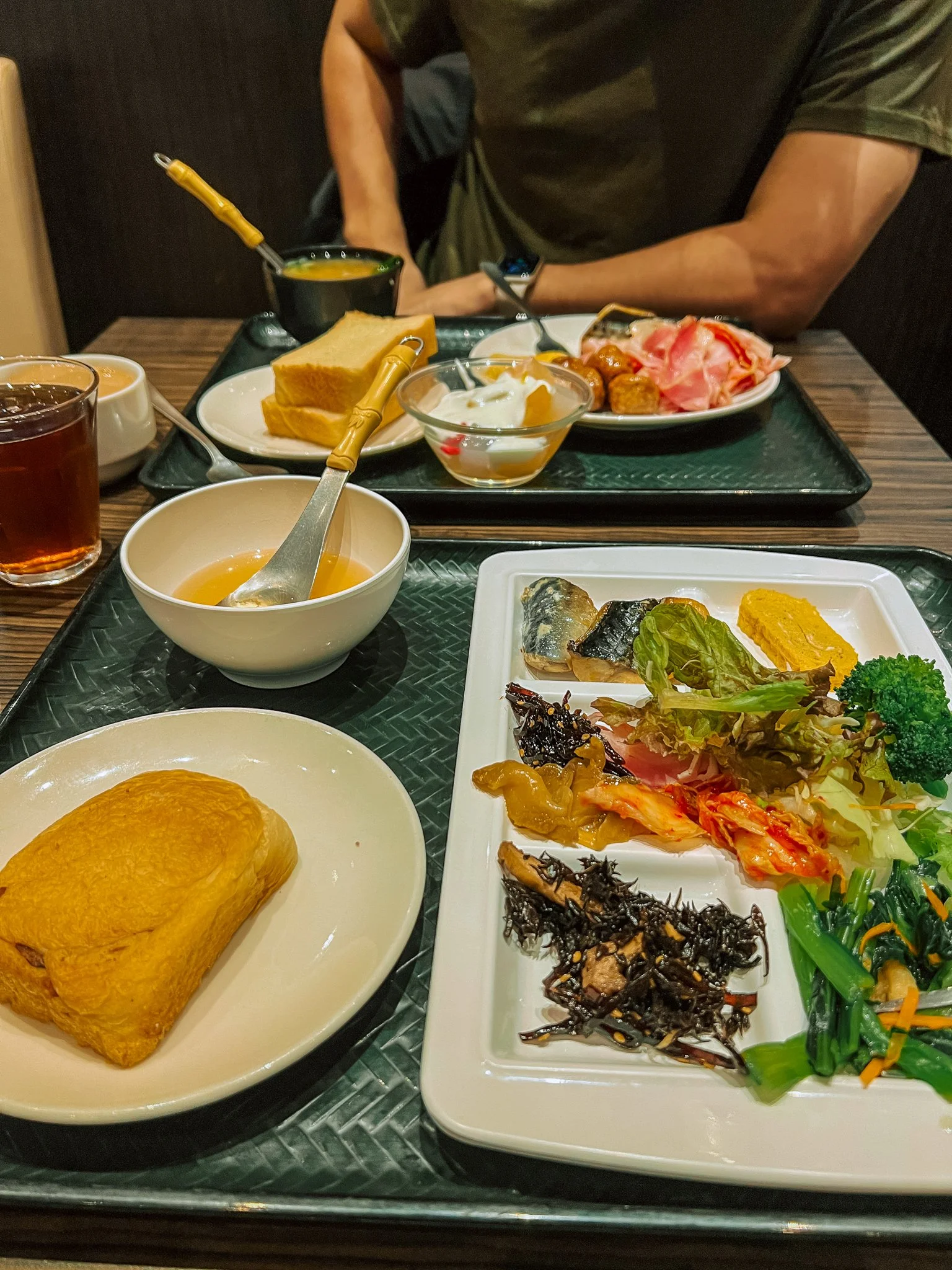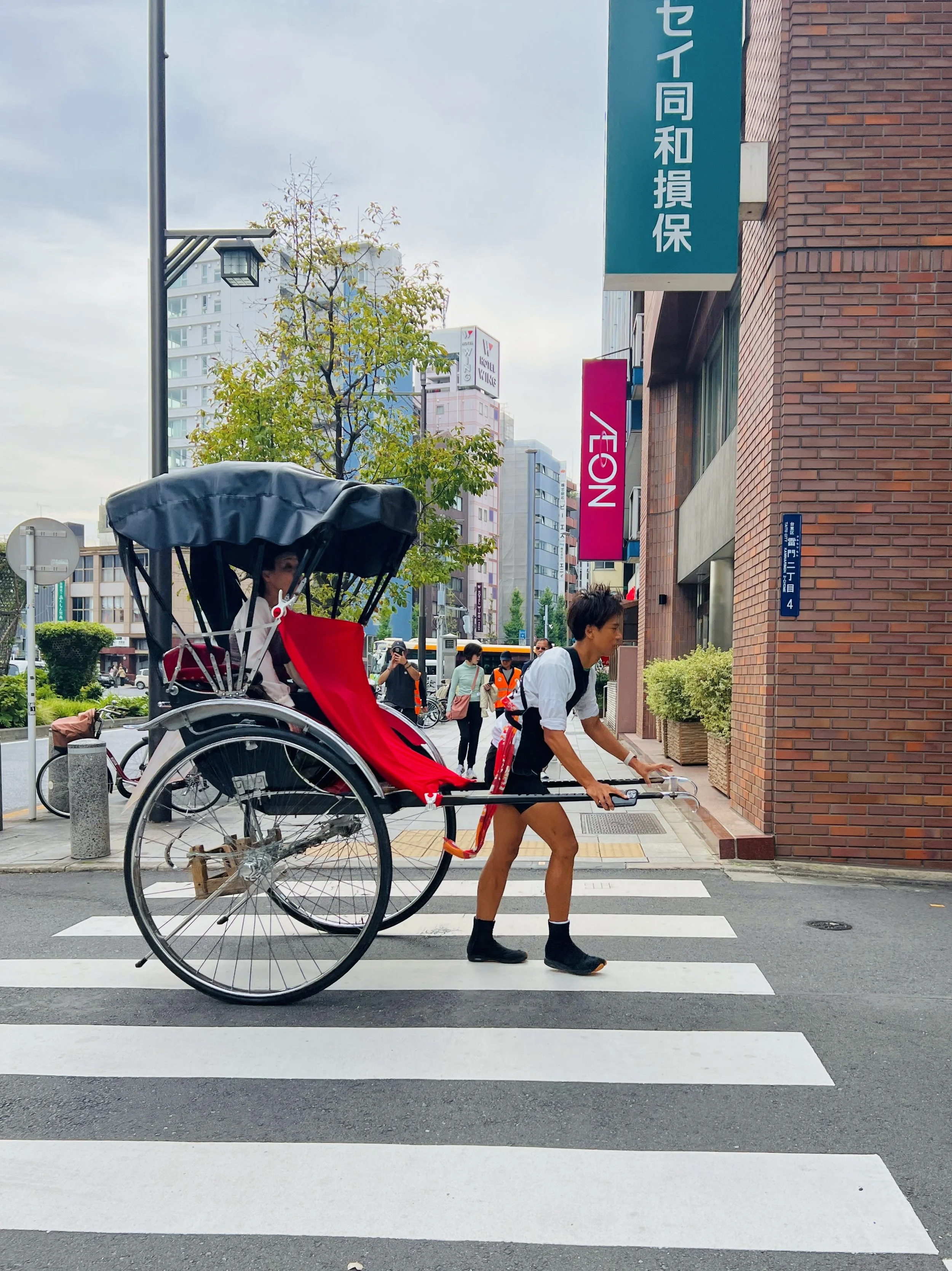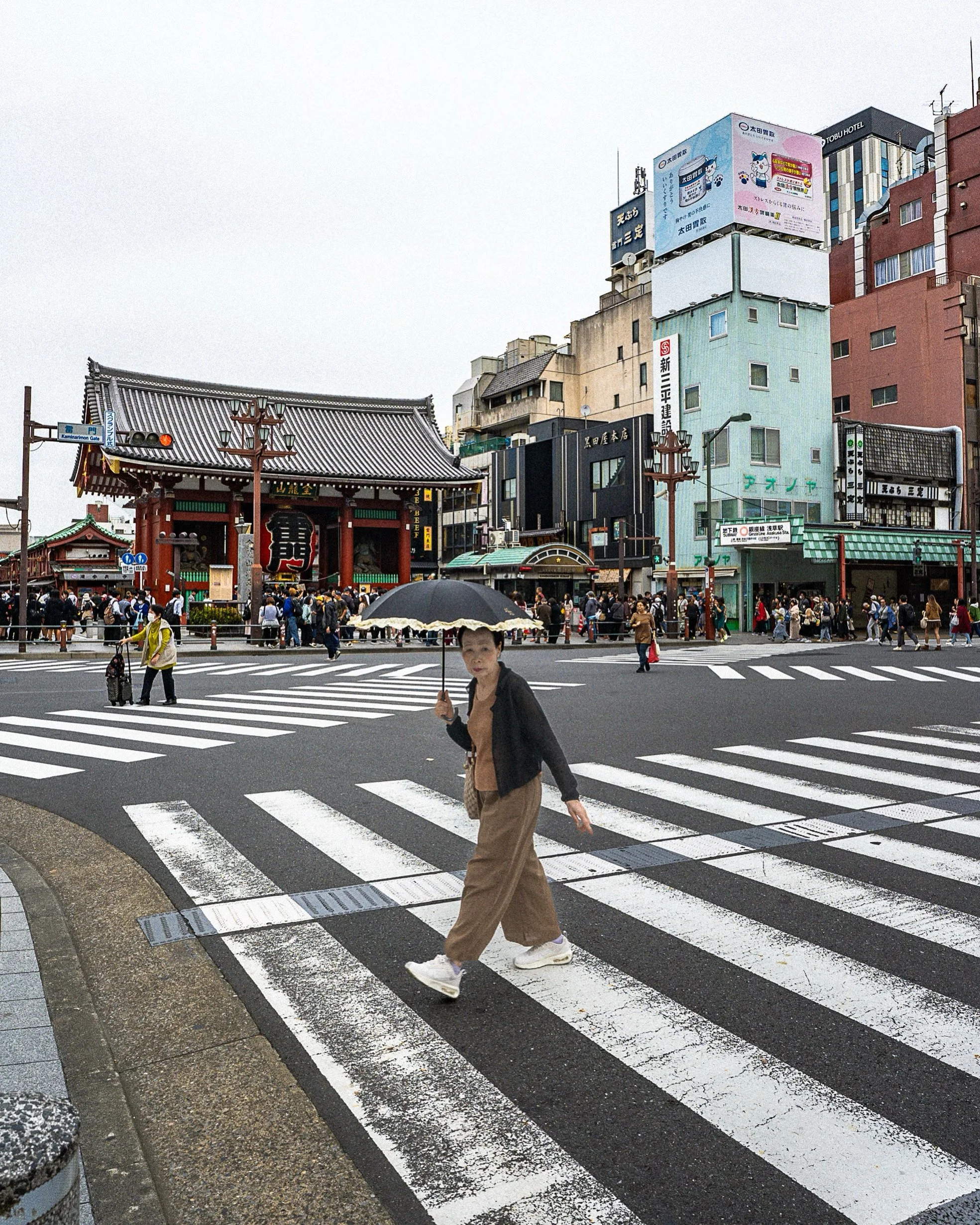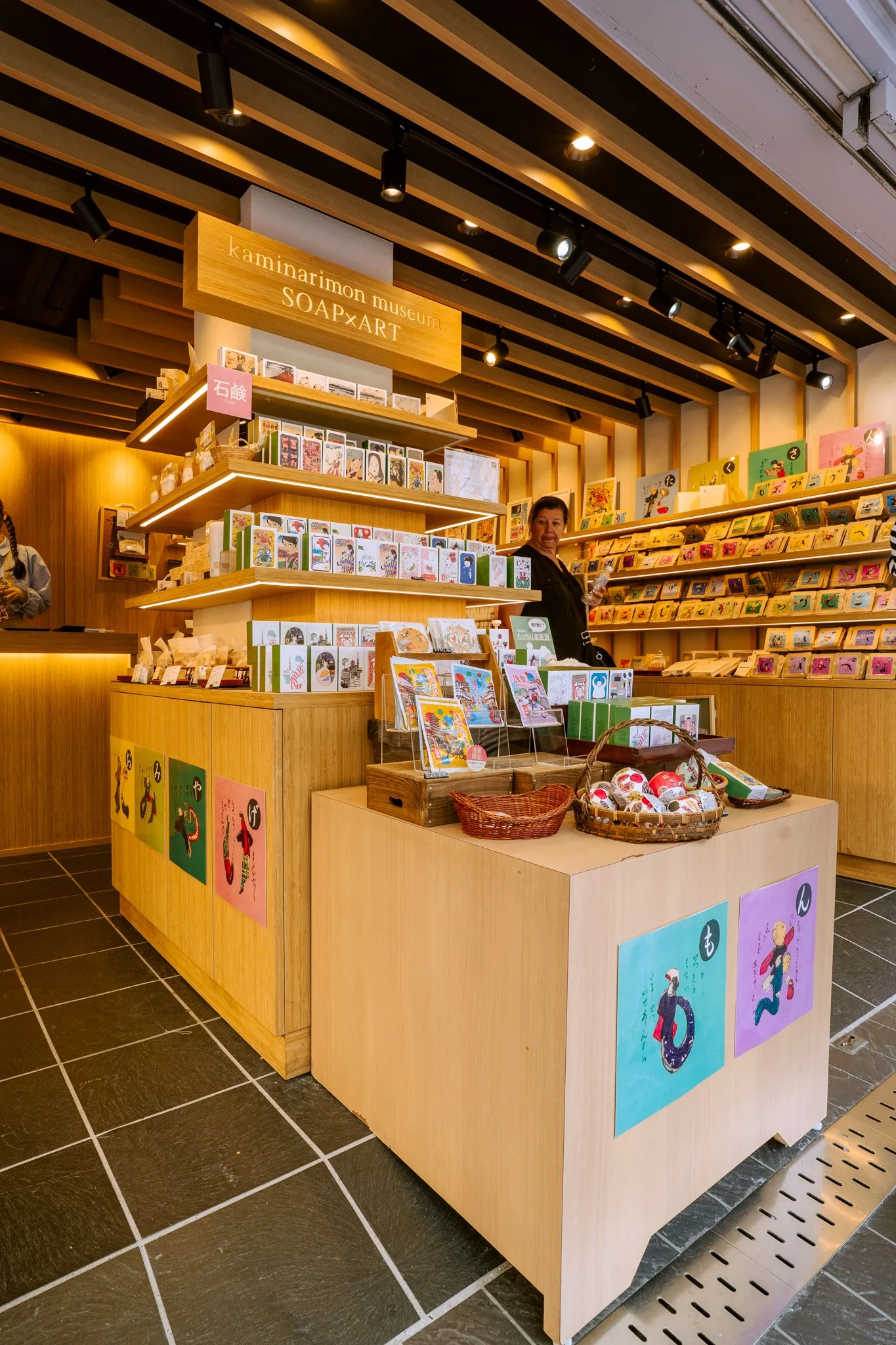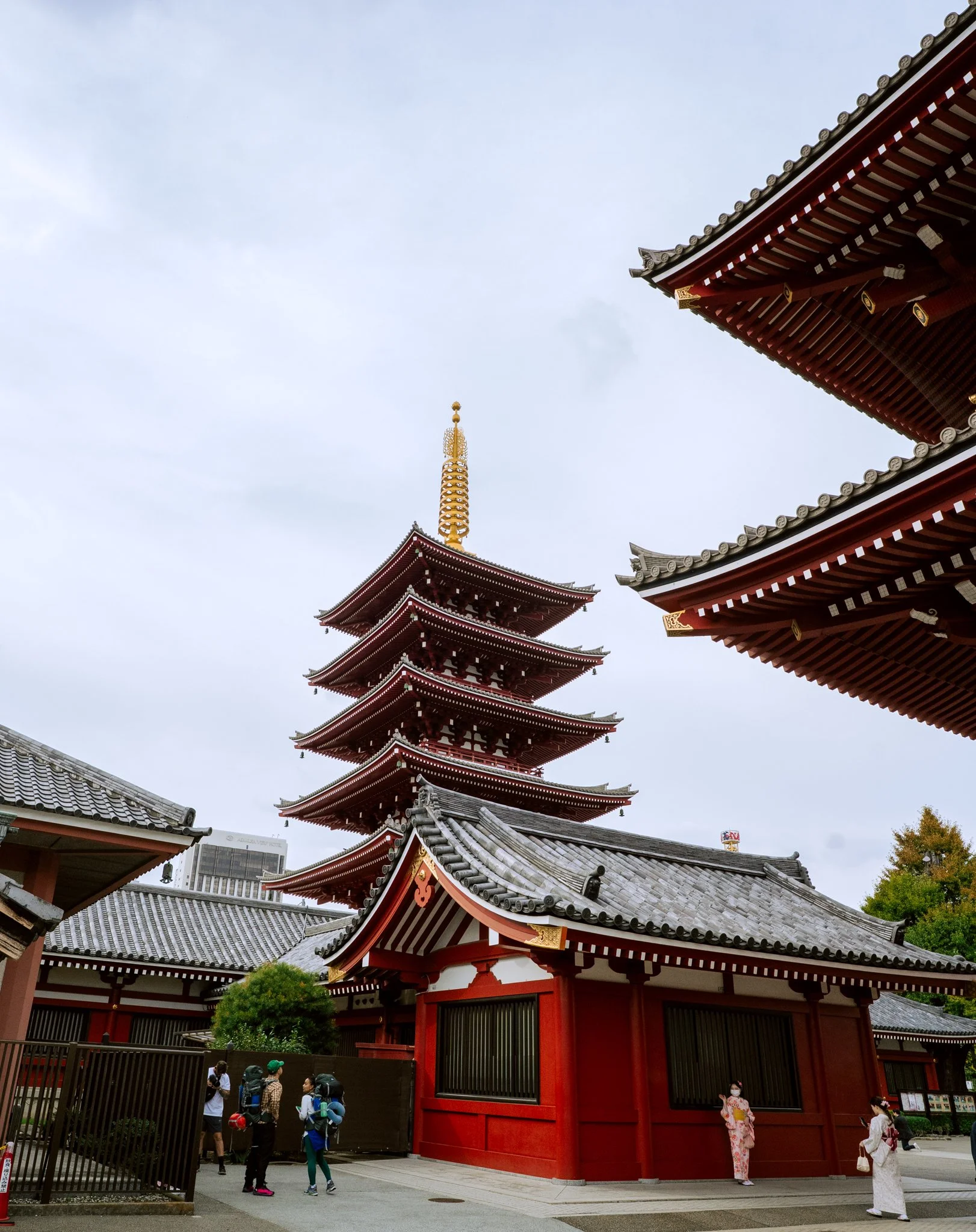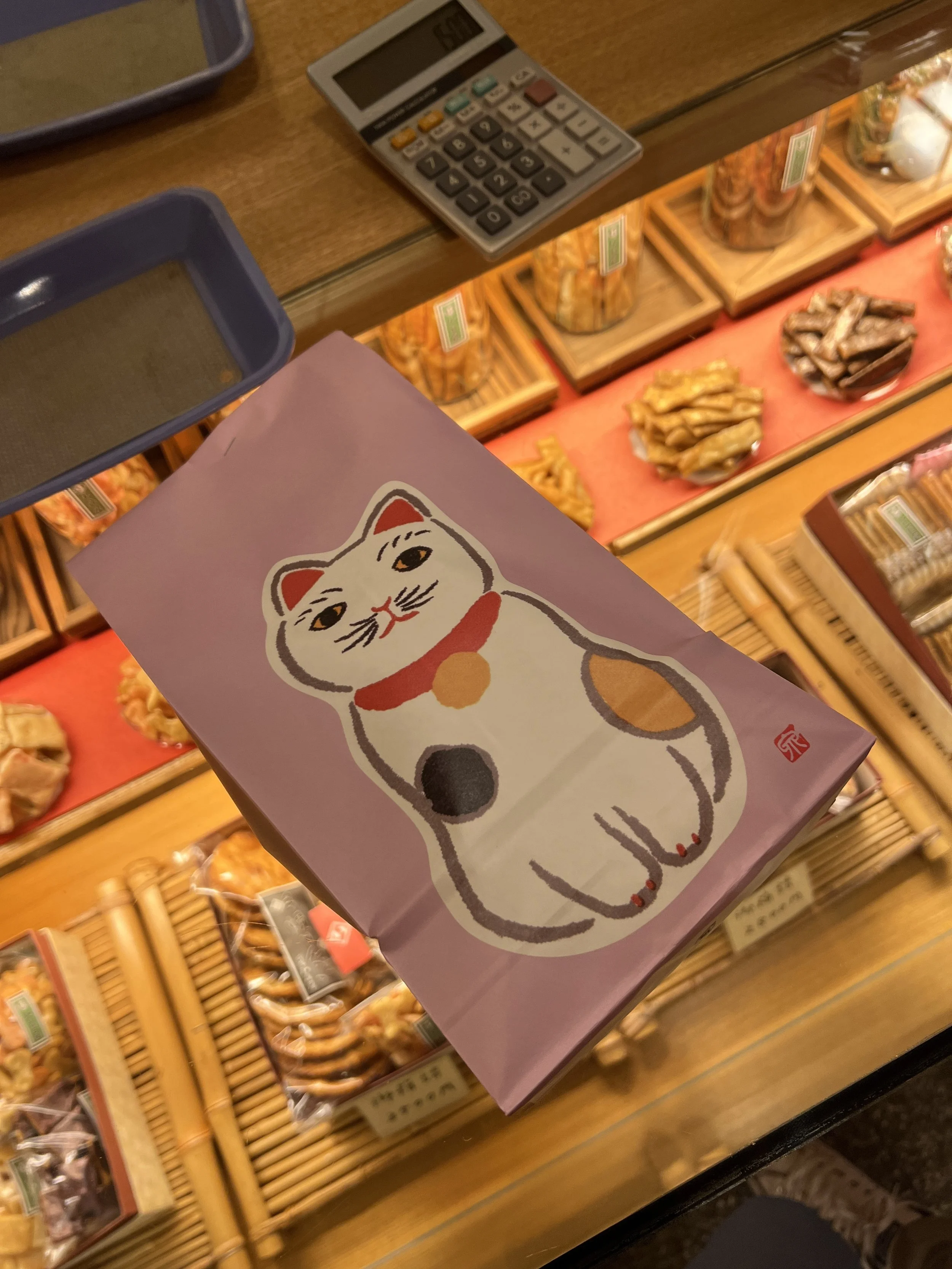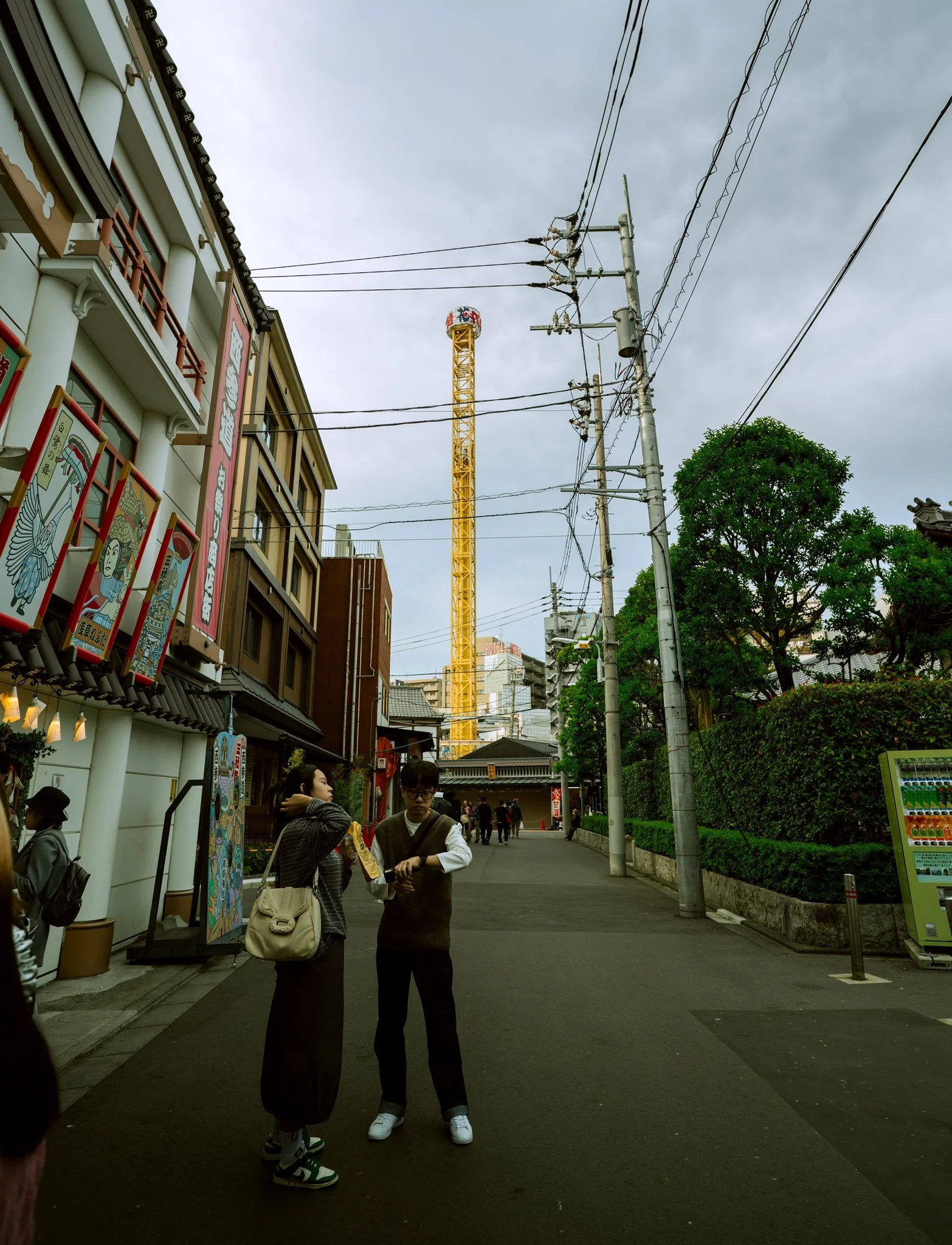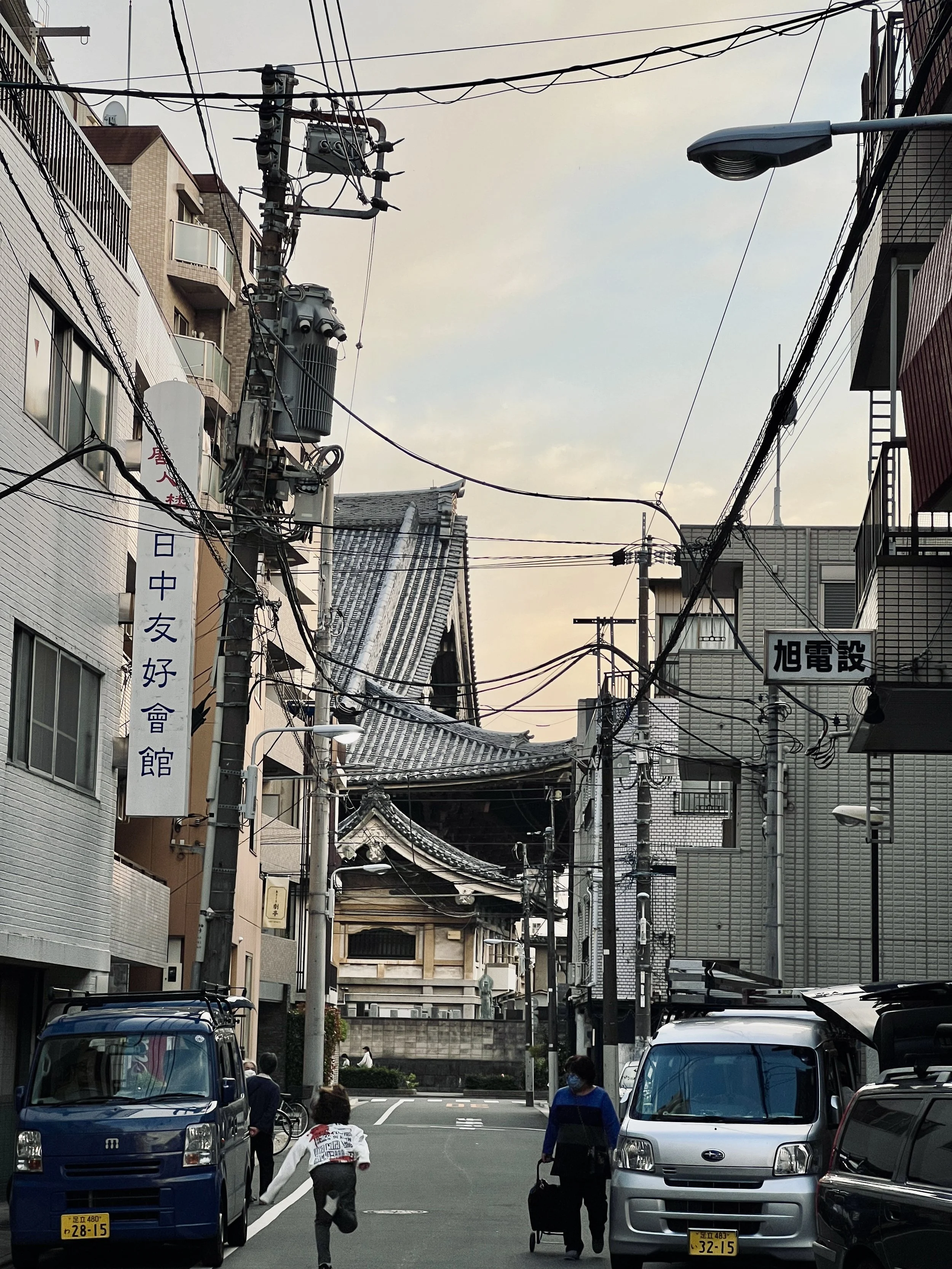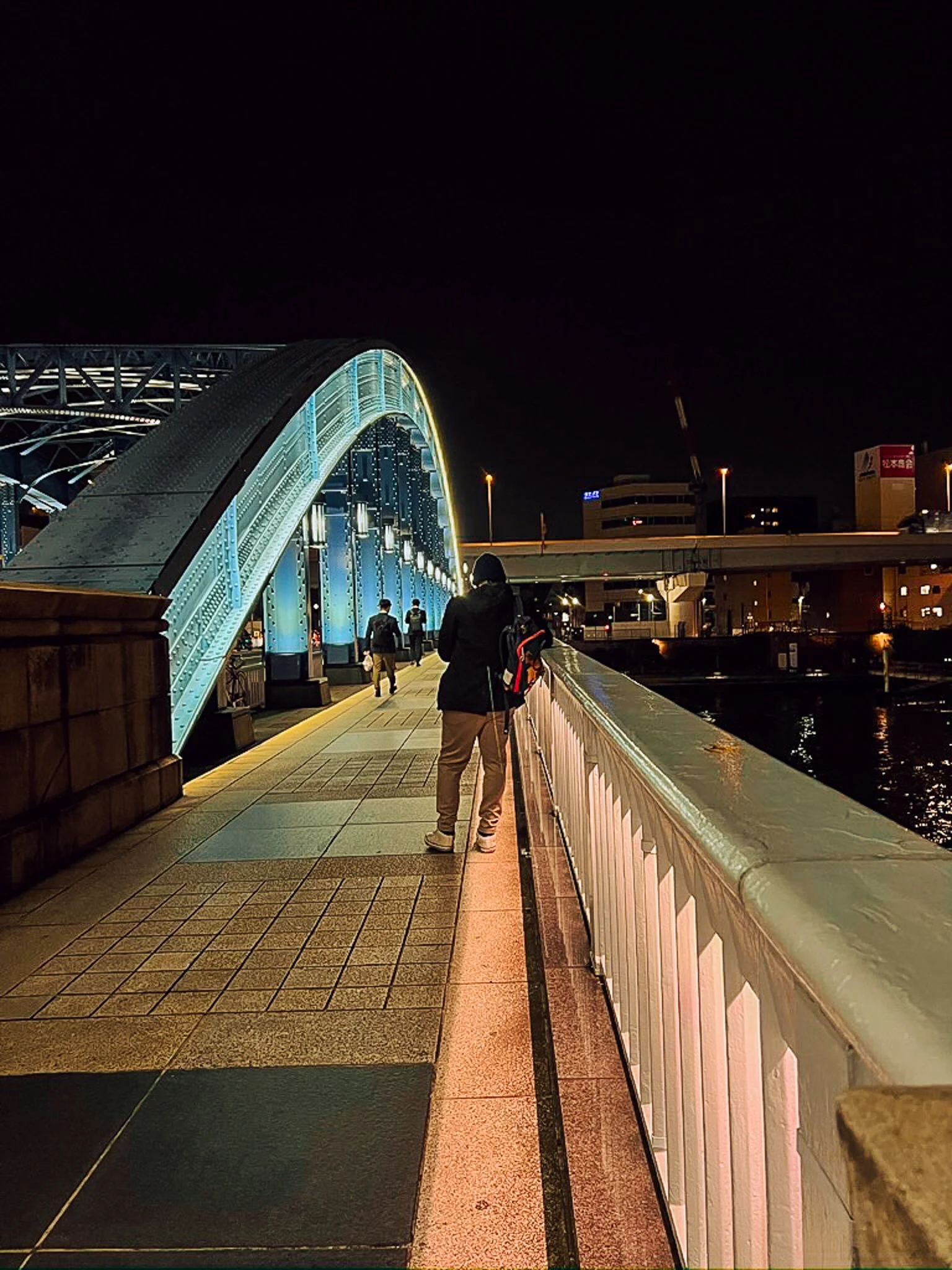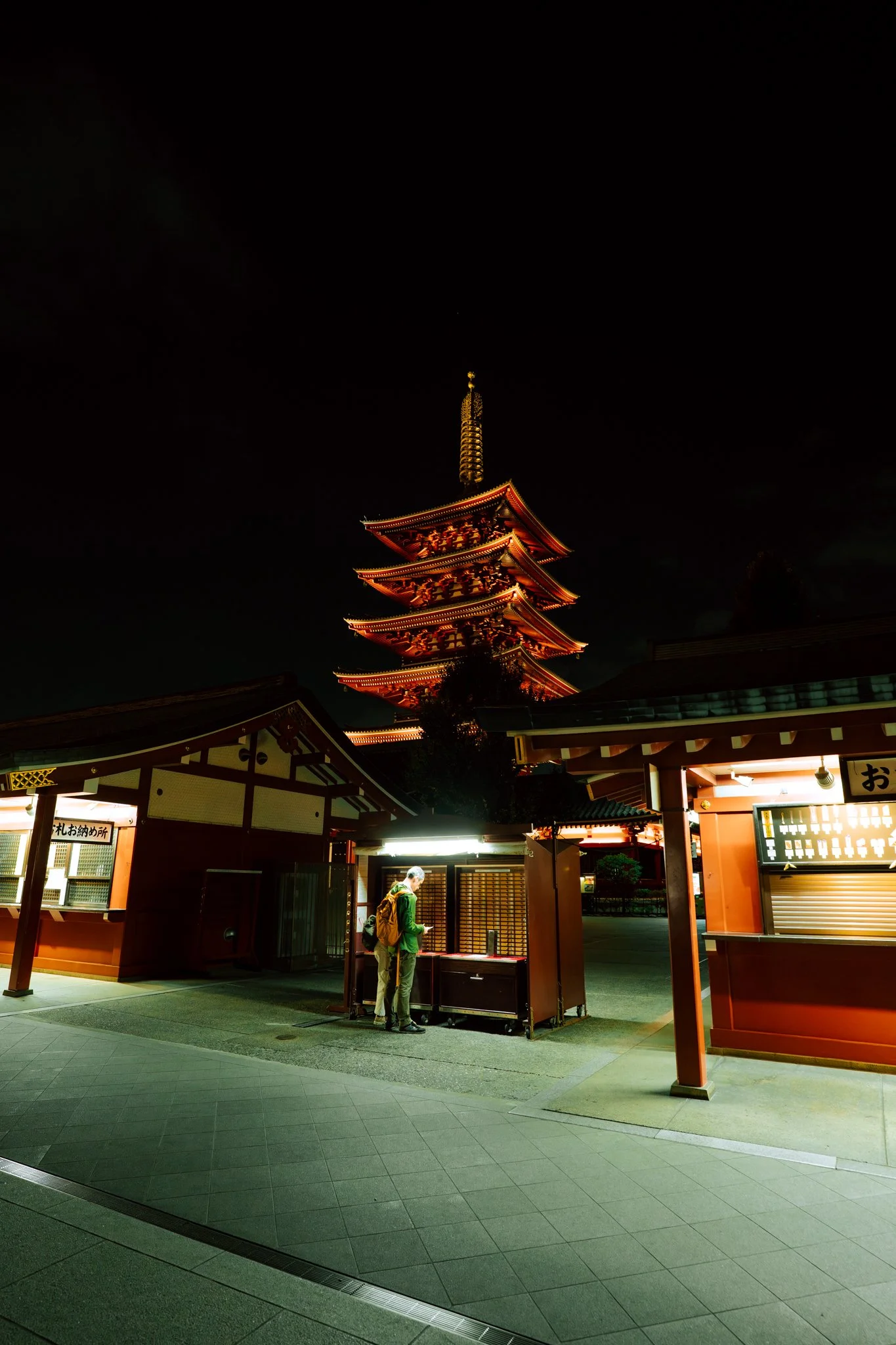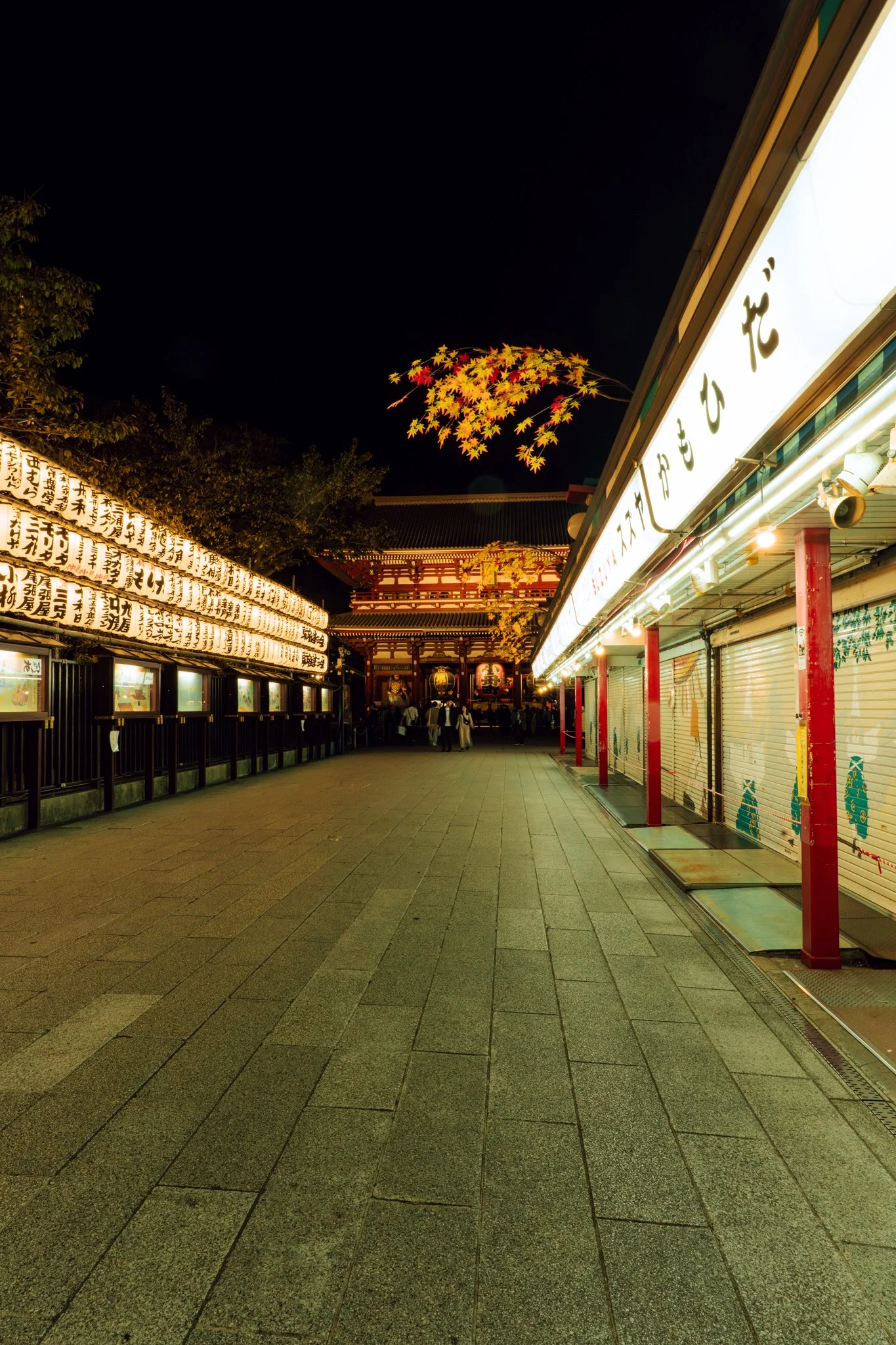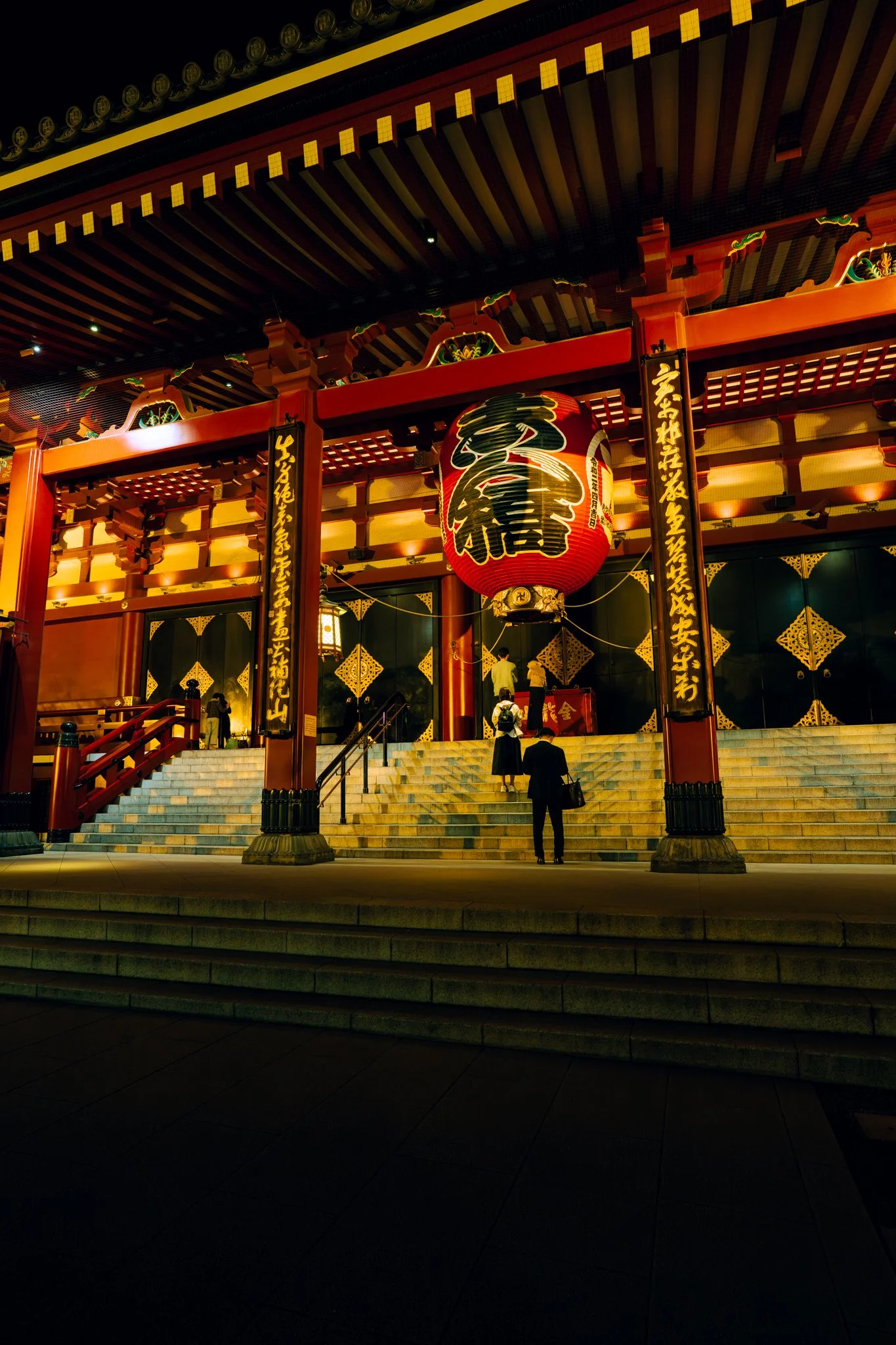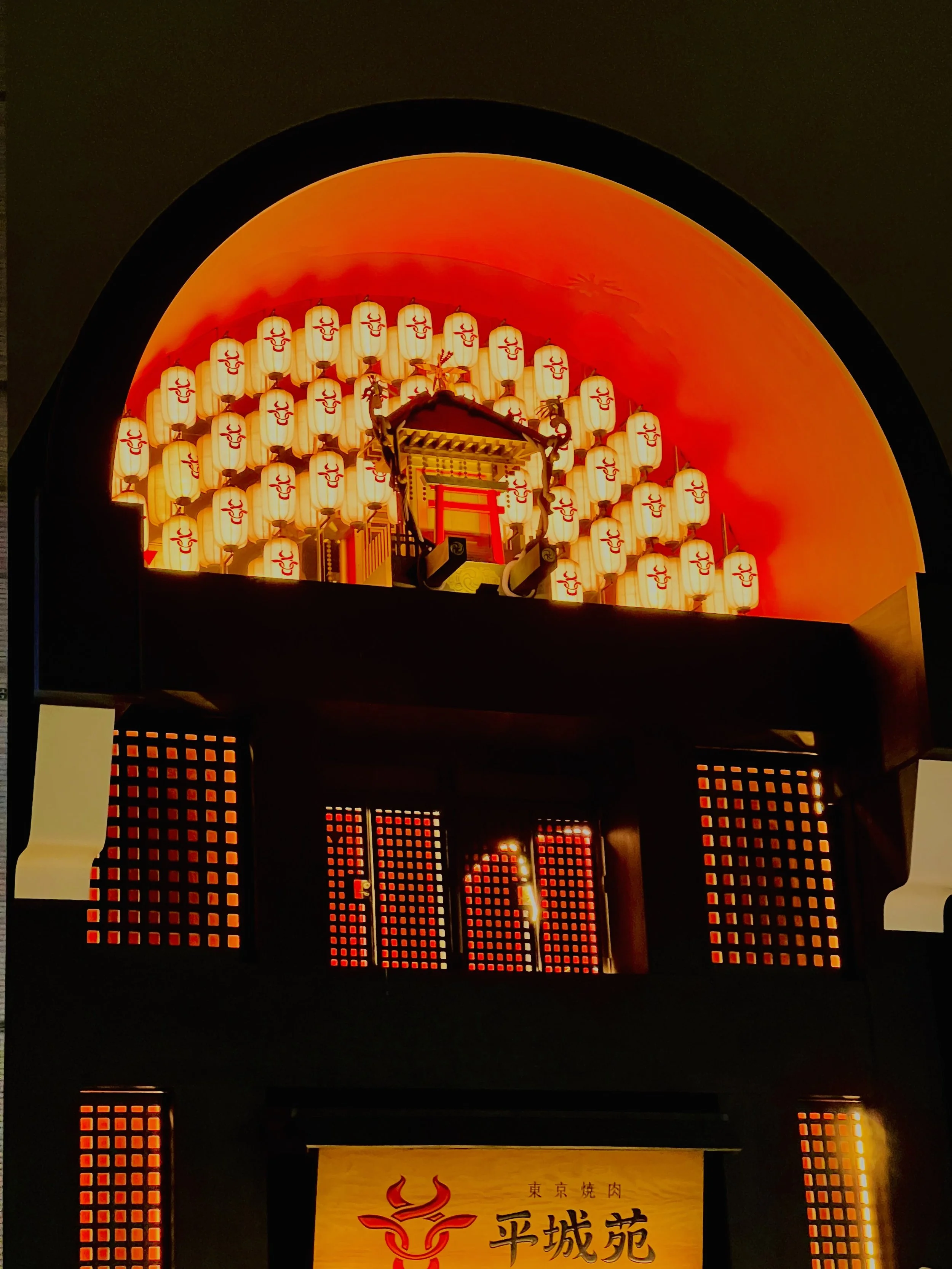Okay, Japan has become my favourite place Part 1: Asakusa
Our first trip to Japan was bittersweet. It was supposed to be my fortieth birthday celebration and a much needed break for us, given the harrowing year we’d had. But a routine hospital visit for our dear Amma, turned out to be the last time she would leave the house. And two days before we were to leave, she breathed her last. It was a terrible time. And honestly, it felt like we’d been to hell and back. So we just decided that rather than cancelling, we would travel a month later. Truth be told, it was one of the best decisions we’d ever made. Because the previous months had left us emotionally shell-shocked, and this trip built a definite wall between the trauma of the past and what the future promised. A definite separation, and I will always be grateful to Japan for this.
Grief-stricken and cash-strained (a year of being in and out of hospitals can do that to you) doesn’t scream “travel mode on”. Even now, when I think back to that October, I’m pleasantly surprised that we had it in us to do this. And I’m so grateful that it had to be Japan. Sweet, welcoming, heartwarming, Japan. Japan has left me utterly bewitched. And that’s probably why I’m going to write these travelogues in crumbs - savouring it bit by scrumptious, broth-rich, norii-wrapped bit.
We landed in rainy, early autumn Tokyo at around 8.30 pm. Our first impression of Japan was a series of “Wow, so nice”. Breezed through immigration in under twenty minutes (at least it felt like that) - “wow, so nice”. The QR codes that promised a breezy immigration, actually worked and delivered the breezing through immigration - “Wow, so nice”. Went down to baggage collection, only to find them all neatly stacked by the ground staff - “Wow, so nice”. Sahit checked his phone to check if his Vodafone connection had kicked in - “Nope, not nice”. Here things started to get borderline tense - it was getting late and me being Miss. Worst Case Scenario had spooky visions of being stranded in the airport. Or worse, wandering the streets of Tokyo like a spook. We were aghast to find that the kiosks where we planned to get my eSIM and ask for directions were closed. How were we supposed to figure this out with no language skills (konichiwa and arigatogozaimasu can only get you so far), zero reading skills and no internet connection! Somehow the airport wifi wasn’t any help either. A little backstory, Sahit and I hadn’t travelled since COVID and we had a bit of “inexperienced traveller whiplash”. But you know how panic sometimes leads to utter clarity and just tells you what you have to do? Well that happened! (Phew, so nice.)
We found our wits and our sea-legs, made our peace that we had to leave the airport internet-blind and just trust the Kamis and the yokais (gods and demons) out there to take us to our hotel. We followed the signs to the station below - to be very honest, Narita Airport is easy to navigate. And lo behold, right there was the mascot of hope, the oasis to the weary traveller - a Seven Eleven. Sahit went in to get something to drink and came out with an eSIM for me. (Wow, so nice) There were other travellers getting money out of the ATM - a sign of ease to come. We tried putting the SIM but for some reason it wasn’t working. The ticking clock was now echoing like a time bomb. We hurried over to the ticket counters with bated breath, almost terrified of how we would purchase tickets. But Japan’s unfaltering “Wow, so nice” mode was omnipresent - this time in the form of a very helpful Railway Staff with solid English skills. She took one look at our pale, panicky faces and as if trying to reassure us that’s it’s all good, she got us our tickets and told us to hurry. The last Keisei Skyliner left at 11 PM and we were quite close to 11 PM.
Then came the hassle of finding the platform. All this wouldn’t have been a hassle if we had functioning internet or functioning helpdesks. We went down a scary flight of stairs (a sign of well developed calves and quads to come) and waited. Trust me when I say say I felt every micro, nano, fraction of every second. The dread that we might be standing at the wrong platform and might go in a completely wrong direction was screaming in my brain. I was convinced that we were going to spend the night wandering the streets of Tokyo. We couldn’t even divide and conquer - not having internet or any way of contacting each other had chained us to one another and our massive suitcases. Even though another railway staff, in her limited English assured us that we were on the right platform, we were not quite ready to trust the forces of lost-or-found in translation. In the next agonising twenty minutes, I learnt that the deep foreboding in the pit of my anxious brain was something I would soon call “reluctantly learning to trust Tokyo”. During those very long 20 minutes, Sahit decided to wander off “to check”. What was decidedly long 20 minutes now became rather schizophrenic minutes. Every second stretched out in anxious waiting, while at once, raced towards the time the train would arrive, increasing the chances of my absent husband missing the train. Not having a working phone connection feels wild, I tell you. But Sahit got back, with reassurances that this was the right train. And in a matter of minutes, the last “right train” left Narita Station with us on board.
The ride was agonising. Because I couldn’t convince myself to “trust Tokyo”. The ride from Narita Airport, which is in Chiba to Asakusa (where our hotel was) is a little over an hour. Tokyo metro closes around midnight - all the information wasn’t really helping my anxious mind. So why did we choose Asakuasa as a base? Well, to begin with Asakusa and Narita are directly connected via the Keisei Access Express. When you have big suitcases in the picture, changing stations and trains are not exactly fun. Secondly, Asakusa is Old Tokyo - the district still carries old time charm and promised a quieter atmosphere. But what I wasn’t aware back then was that the last Keisei Access Express left Narita at 9.25 PM, when we were still wandering the halls of Narita Airport.
Anyway back to us, slowly trundling our way to Tokyo. The train had a handful of people to begin with - and by the time we neared our station, which is the last one, it got pretty spooky and lonesome. So you can’t blame us for get really alarmed when the train stopped at Ueno Station and it looked like it was the last stop. Everybody got out. And then things got so confusing, that we were convinced that this is the last stop. Which now I realise, after two years, was actually the case. The train that I fondly believed was the Keisei Access Express (which goes all the way to Asakusa) was in fact, the Keisei Skyliner (which stops at Ueno Station). We got out, confused out of our wits, and bumbled around asking for directions. When I say bumbled, I mean going upstairs, downstairs, upstairs again with massive suitcases in tow. Not the funnest thing after a 16 hour journey. At that late hour, there were no station staff who spoke any English, and we had no way to communicate. I think they were trying to tell us that there were no more trains, but we thought they were telling us we needed a ticket. They were helpless, we were helpless - and seeing their helplessness, made us feel even more helpless. Because the Japanese brand of helpless “I want to help you but I don’t know how” will break your heart. Finally we got so tired we just went into “Trust Tokyo” mode and walked out of the station - just to put us all out of our collective misery. We were like “we’ll walk if we have to”. This sort of cemented my relationship with Ueno Station - later posts will explain why. But we didn’t have to walk, because there was cab right there. It was all very quick and matter of fact after that - our hotel was less than three kilometres away, we paid some 2 or 3 grand in INR for our short ride. Tokyo was quiet and deserted, and I shivered at the thought of wandering around alone in sleeping Asakusa. I was learning to trust Tokyo, and the Kamis and Yokais that be. It wasn’t just the cab driver that I thanked after that ride.
We were staying at the APA Kuramae Kita hotel. And calling the rooms small is a huge understatement. Tokyo hotels are cramped and quite pricey. It’s just something you have to accept and move on. Unless you’re made of money. Then you can move into a reality of huge hotel rooms in Tokyo. #manifesting But however you feel about the rooms, there is no denying, even though the bathrooms are the size of your nail cutter and the size of the bed supports the theory that Titanic Jack did, in fact, have space on the door and Titanic Rose was just hogging - the toilet does not fail to deliver. The Japan potty will have you weeping for months after you’ve left Japan - you will miss it and its efficiency so much. You’ll miss the warm hug your bum gets every morning. But that’s not all that you’ll miss in these doll-house sized bathrooms. The run-of-mill hotel bath products will still surpass your luxury stuff back home. You’ll also miss how fluffy your hair gets in Japan. There is magic in those shower heads. And they don’t come cheap. With these quick, preliminary assessments of Japan’s attention to detail, we went to bed. We had no idea!
The next morning, we stepped out for breakfast, to an Asakusa glistening in a light rain. Quiet, peppered with elegant Tokyo-folk purposefully marching, nay gliding, to work. A few transparent Tokyo-motif umbrellas make this random workday morning, “urban picturesque”. A random workweek morning that is almost as quiet as it was in the dead of the night when we arrived. Even the cars glide soundlessly on the roads. The hotel breakfast was served in an APA branch a couple of buildings away. Japanese breakfasts are a culture buzz - a different feeling alright, but way too pleasant to be called a shock. I was so tickled that mackerels were at my breakfast buffet. The almost-too-dainty-to-be-eaten tamagoyaki, a Japanese omelette, had me lost in their delicious frills and ruffles. Though I was not quite ready for the “chocolate spread” that I spread generously on my toast, turning out to be red bean paste, I quickly got used to it and began liking it. I realised that I was totally a fan of having rice/miso soup/veggies first thing in the morning. Sahit couldn’t get enough of konjac jelly and yoghurt. Fuelled by a breakfast unlike any other breakfast we had so far, we went onto to explore this land, that was unlike any land we’d travelled to so far.
Let me make one thing clear - Asakusa in 2023 and Asakusa in 2025 were two different animals. In 2023, it was a zen, benevolent bear with episodes of flashy-touristy behaviour. In 2025, it was a junkie bear by day, and a meditating ghost by night. But about that later. All roads in Askausa lead to the Senso-ji Temple. It is the beating heart of culture and commerce, and has an aura that somehow holds itself distinct, like as if it were levitating, above the mayhem of touristy activity that buzzes around it. On this crisp, early November morning, we began to get to know Tokyo. The Sumida river rolled by and on the other side, the Tokyo Skytree loomed behind some distinct architecture - one massive gold tooth, one massive gold turd on a businessey looking building - and all together, they looked like they were ready to drop an album soon. We didn't know it yet, but the Skytree would, in time, become a sort of guardian angel stand-in for us.
Tokyo has understated attitude and it was everywhere. Tokyo also has clear and present charm - and we were falling for it one traffic-stop chirp and coo at a time. To go from the land of pointless honking and chaotic traffic to cooing traffic signals and people following rules - we didn’t stand a chance. Around us, tourists battled with their life’s or rather their Japan’s choices, in the form of suitcases. Locals walked by, poker-faced, silent tolerating - their politeness sorely tested. And yet, like Senso-ji, we felt removed from it all, a sort of zen.
In no time, we saw our first Japan “rickshaw”. The jinrikisha is a very aesthetic-looking ride with a very aesthetic-looking young man manning it. Honestly it’s like Magic Mike, Nihon edition. And they are very aware of their aesthetic power, because they really flex it. Well, it’s good for business. These rickshaws are portents, letting you know you’re elbows deep in tourist (and tourist trap) land. And little further down, was the temple.
We walked through the outer gates, the Kaminarimon or the thunder gate with its massive lantern. Tourists in various touristy garb that ranged from yakutas (an informal kimono) to run of the mill sneakers and athleisure clamoured to get that picture in front of the lantern. In the shadowy depths of the gate, two thunderous, massive figures glowered upon this casual disrespect with darkened but nevertheless helpless brows. These are the Shinto gods Fujin (the god of wind) and Rajin (the god of thunder). On a plaque on the massive red lantern, a more modern, but no less commercially successful god’s name is etched - Matsushita Denki, an abbreviated version of Panasonic’s old name. The gate that originally dates back to 941, was reconstructed after a terrible fire in the 1800m and Matsushita Denki Sangyo Kabushiki Gaisha (Panasonic) paid for the restoration - branded content before branded content was a thing.
Ahead the Nakamise Shopping Street, one Tokyo’s oldest, stretched with a human density of 100%. This had to be one of the most sensory overloads of my life. Being jostled around with people from different countries, with the most delectable cute things waving from the stalls on either side. In this hubbub, you could pick the Japanese out with a chopstick - them in their functional-elegant-chicness really stood out. Japan does not take a break from being “aesthetic” - and it made my head spin in delight. But right now, it was all the yummy snacks and cute souvenirs that were hitting all the right parts of my brain. Eating and drinking while walking is frowned upon in Japan - so while your elbow is coalescing into someone’s anatomy due to “way too close” proximity, you have to stuff your face quickly by the side of the stall and move on. Also Japan is big on cash - especially in stalls like these. Come with heavy purses, or live to regret it. Talking about heavy purses, Japan’s heavily adorned programme of regulating one’s nervous system also includes install a completely warranted sense of security. Japan is safe like no other destination I’ve been to. I felt confident to wear my backpack AS A BACKPACK (Wow, so nice). It was a new travel sensation and we were loving it.
Over these bobbing, moving, heads, the second gate to Senso-ji sits like a meditating monk, so removed from the materialistic hustle at its feet. And it’s only fitting for it is Tokyo’s oldest temple, dedicated to Kannon, the Bodhisattva of compassion. The deep vermillion resonates with some spiritual aesthete in me. I feel grounded - which is weird for a claustrophobe like me. We walk thorough a second gate, the Hozomon or Treasure Gate with its three impressive lanterns. The formidable glowering gods within the gates are protective deities this time around. I don’t know what the ever present “mon” in Japanese nomenclature means, but it was beginning to sound quite Malayalee-types (more about that later). Also the architecture of the temple vaguely reminded me of Kerala temples.
On the right, there is a small building - a bevy of fuss and clunking sounds. This is the Omikuji where you can draw fortune slips. You drop a 100 yen coin into the slot, take the tube tin and shake it till a wooden stick pops out of the slot on top. You match the kanji on the stick with the drawer (there are a set of drawers), open it and take out a fortune. If the fortune you take out isn’t nice, you tie it to the line outside, so as to leave it at the mercy of the gods that be and not take it home. Of course, the place was crowded and we decided to give it a miss. But this hollow thunk is one of the aural motifs that would remind you of Japanese Temples. We made our way to a massive incense burner - apparently whiffing in the fumes is supposed to make you smarter. Japanese temples have a fountain where you cleanse yourself before going in - both hands and mouth. The fountain had impressive dragon spouts that continuously watered the fountain. As crowded as the temple is, you have to hand it to the valiant faithful who come with their sincerest prayers amidst the throngs of bumbling tourists. Sensoji is a Buddhist St. Antony, known for granting prayers. So don’t forget to take your fondest prayers.
To reduce the Sensoji experience to a series of genuflecting and five yen coins (the preferred offering for good luck) and incense is terribly unimaginative. It was so beautiful, that I wanted to cry. My heart was sore with wanting a subject to photograph. All these women in kimonos, like little walking pieces of history, and nobody I could photograph. The grounds of the temple, the five storeyed pagoda, the little koi stream in the zen garden that caught the sunlight like precious gems did - strobes of emerald, jade and ruby. My heart burst into fireworks at every thing my eyes framed. I sat there, bedazzled and bewitched. I could feel Japan casting a spell on me. A spell that holds fast yet, two years and a second trip later.
Time slips faster in places that hold history. When I think back how we spent an entire day wandering around the Sensoji’s octopus arm-like alleyways, it feels rather wasteful. But what treasures we found. Rice crackers, mochi-lollypops, matcha in every conceivable this and that form, bargain kimono-like overlays and so much more. We snacked our way through historical alleyways. We snacked our way through not-so, extremely tourist-trappy alleyways. We snacked our way through pub-filled alleyways. We snacked our way in ways we didn’t know possible. Snacks that were just as a fest for the eyes, as much as the eyes. It’s as if there was a memo passed that everything should be “kawaii” or cute. Well, turns out there was some official memo to this effect to rebrand Japan’s image after WW II. I was never more enthusiastic about being emotionally manipulated.
Japan was turning out to be scrumptious, in every sense of the word. We were on dangerous turf. We were for the first time, in this boggy ground of “great exchange value”. Japan is the first Asian country we ventured to (blame it on some weird allergy I had every time I ate at sophisticated Vietnamese and Thai restaurants). All our “going to foreign” trips so far were to Europe. And we had very tight budgets allowed for each day. Rules. Good, sensible rules. That were quickly disappearing at every price tag we marvelled at. (“F**k! So cheap! Are we dreaming?”). We began to play fast and loose with our money. And we were so unrepentant by the end of the day. Bangalore/Bengaluru is such an expensive city and in comparison, Japan was making us feel like our currency had value. (Wow, So nice!) This was a sensation that I had never experienced as a traveller. And I was loving it. We checked out the Don Quixote - decided to come back later. Found out the hard way that we’re better off not entering izakayas (casual drinking joints) that invite you in with English - Otoshi or the “so-called complimentary” appetiser in touristy areas can be a bit of rip-off. Most places inform you at the time of seating, so do be conscious of it. We were happily conscious of the fact that we were going around in circles. But we had no problem with that, because this meant we found things to eat that we missed earlier. Asakusa boasts Japan’s oldest amusement park (dates back to the 1800’s) - though we didn’t really visit it, it contributes to Asakusa’s eclectic skyline.
And then we thought we’ll check out Kappabashi street. A *Kappa* is a yokai that tricks you into a waterbody and drowns you. And just like its namesake (and now mascot), Kappabashi Street drowns you in a pool of “I want that”. The historical kitchen street is filled with all kinds of gorgeous homeware and ceramics. Each piece has you imagining a whole future with it. And if your weakening resolve was still holding on to some sparse dignity, the price tags with have you buckle in no time. Everything is so affordable, the stores are so cute - often manned by sweet elderly folks who are happy to have you visit their store, that you make several choices that will have you wondering “what was I thinking” when it’s time to pack your suitcases. In Japan, don’t expect to “come back” for something. If you like something, buy it right away. Or it’s lost forever. Just when we were getting used to the “everything is affordable” narrative, we walked into a knife store - and things got ironic very quickly. The Malayalam word for knife, kathi, is slang for something super, pocket-rippingly expensive. To put it simply, Japanese knives’ prices will cut you. Japan takes its steel very seriously. Some stores offer to etch/carve your name into the knife handle. That’s some katana code hardwired in there. We picked a few things up and made up our mind to come back later.
Since we had to fly in and out of Tokyo and we were a little inexperienced, the first time around, we had decided to keep the itinerary simple. Or rather what we thought was simple. But honestly sticking to the Tokyo-Kyoto-Osaka-Tokyo circuit is a huge disservice, not to mention, heavily trodden and heavily crowded. We had enough of crowds that we didn’t even go to Osaka. But including smaller towns often gets you bigger hotel rooms for your money, a lot less crowds and a stronger connection with people. We deferred our “big shopping” for the couple of day we would be back in Tokyo after visiting Kyoto. A single encounter with Japan’s formidable stairs, really put the fear of god in us. It’s not mystery really why people in Tokyo are quite fit. Stairs, ridiculous social pressure and zero-wriggle-room body standards.
Anyway, we headed back to hotel - exhausted and feet screaming in disbelief at the 17,000 steps we had put them through. They had no idea this was going to be the new normal for the immediate future. We stopped by the nearest Seven Eleven for a little “mosey”. But unwittingly was just following one more step in Textbook Japanese Tourist behaviour.. We filled our basket with a whole lot of questionable choices. If my forty-something feet could get with the (intense) programme, so could my stomach. We spent a good portion of the next hour in our hotel room confusing/delighting the living daylights of out of our digestive faculties. Your convenience store (or as the Japanese call them - konbinis) hauls really take the edge out of the smallness of the rooms. Claustrophobia doesn’t stand a chance in the face of konbini sushi, melon bread, sando (sandwich), katsu (meat cutlets), Meiji chocolates, custard cups, and the undisputed crown prince, the onigiri. Those soft, triangular pillows of soft rice, with a heart of flavourful salmon or roe or beef or pickled plum, wearing a sash of seaweed really brings the ummm in umami. The brain just can’t process any downers when it’s floating on the konbini happy cruise.
We thought we were ready to call it a day. But nope. Sensoji demanded a second audience. And at 8 PM we walked into a barely recognisable Asakusa. It wasn’t that late, and yet, it was like a parallel universe’s version of Asakusa. We thought we’d take the scenic route. All the way over the Sumida River, a long stroll over the opposite bank. Save for a few night joggers, we were pretty much on our own. And yet, it didn’t occur to us to feel unsafe. The Sumida River is an urban lyric. Several bridges traverse its length. And in the far distance, a metro chugged along like moving Christmas lights. It was so pretty. On the other side, Asakusa glowed like a showy jewel.
It was time to heed the call of Sensoji. Nakamise Street was now a shuttered, deserted stretch with a smattering of tourists and the faithful. The alleyways were shadowy arms that led to spectral dimensions you did not want to explore. Each shop shutter was a painting, but gave you an uncanny feeling of being watched.
The Senso-ji Shrine is a whole different world by night. By day it’s buzzing. Hordes of tourists. The shops are universes unto themselves. Gorgeous, colourful wares call out to you. Lovely women in kimonos totter around, like little time travellers. The smell of food twists your neck every which way, giving you some kind of sensory whiplash. The clatter of charms, thick clouds of incense and a blanket of human voices become a sort of defining feature - one that you’ll associate the temple with, every time you think of it. It’s alive. It’s determinedly human.
But at night, it comes alive. It’s all secrets, shadows and mysticism, as the kindly spirits close shop and stop hearing prayers. And become forces of a different kind of influence. One that’s not quite indulgent and is far more interested in how you intend to pay for all that you’ve asked in the form of prayer, than your prayer itself. And yet, this is the side you connect with. Even if it’s a little terrifying. A little like looking god in the eye and you’re not quite sure if you’ve managed to get away with it.
A light rain began to fall. Asakusa turned electric. The wet streets became an airspace, filled with a traffic of frenzied, whipping luminescent dragon trails - red from taillights, yellow from the streetlights, a havoc of greens, a gasp of blues, roars of neons from the signages. Raindrops were mirrorball shards. Through every alleyway, every gap in the skyline, the Skytree waved at us - always a friend. From various doorsteps, wily Tanukis, the bear badger, wished us good fortune - a sight we would grow to love. And in this rhapsody so sublime, we realised that we had available real estate in our tummies. (What in the gluttony!!) It was a bid to sanctify our first day in Tokyo with the ultimate touristy cliche - ramen. Warm, welcoming ramen - no wonder it rhymes with amen. It’s impossible to polish off a bowl of ramen without feeling a sense of accomplished wellbeing. I was aglow with the warm fuzzies. Sitting across my husband who was decidedly forming a relationship for life with ramen, I knew that I was quite in love.

